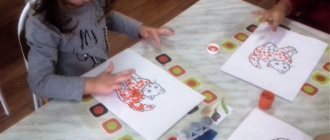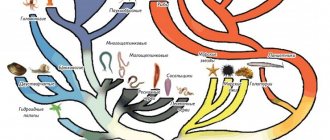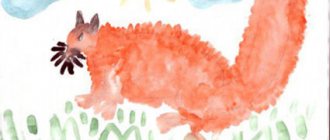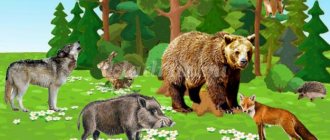Lapbook “Wild and Domestic Animals”
Maria Kazakova
Lapbook “Wild and Domestic Animals”
Lepbook “ Wild and Domestic Animals ”
.
Goal: to consolidate the knowledge of preschool children about wild animals and their young.
— consolidate children’s knowledge about wild and domestic animals ;
- develop the ability to distinguish between animals and their young , correctly correlate their names;
— broaden their horizons and activate children’s vocabulary through familiarization with new animals ;
— develop children’s mental processes: attention, memory, thinking;
- promote the development of coherent speech and articulatory apparatus.
— to cultivate a sense of love for the surrounding world, caring attitude towards the inhabitants of living nature ;
-develop an interest in living nature
Dear colleagues, I present to your attention the lapbook “ Wild and Domestic Animals ”
.
This manual was created with the goal of introducing children to forest animals and domestic animals , teaching them to compare animals by appearance , finding mother and baby, the shadow of an animal , and naming parts of an animal’s .
The laptop consists of the following games:
1. Name the animal
Goal: Expand the understanding of wild and domestic animals , teach them to name them, name parts of the body, describe the animal and its distinctive features. Enrich children's vocabulary on the topic. Develop memory, attention, thinking. Cultivate perseverance and accuracy.
Purpose of the game: to teach children to find given silhouettes by overlapping. Develop logic, thinking and visual memory.
Teach children to correctly identify animals and name their babies.
Teach children to find an animal's body part - the tail , and develop attention.
Teach - Develop fine motor skills of the hands, teach how to correctly assemble an image of an object from separate parts, consolidates children's knowledge about wild and domestic animals .
Didactic game “Wild and Domestic Animals” for children 2–3 years old Today I want to show how I designed the game “Wild and Domestic Animals” for toddlers. The purpose of this game: to form. Didactic games made from felt “Domestic and wild animals” and “Who eats what?” Didactic game “Who eats what?” Goal: to consolidate children’s knowledge of what different domestic and wild animals eat; develop thinking. Double-sided lapbook on ecology “Wild and Domestic Animals” If I pick a flower, If you pick a flower, If you and I together We also pick flowers, All the meadows will be empty and there will be no beauty! Lapbook now. Short-term project “Domestic and wild animals” Short-term project “Domestic and wild animals” Prepared by: Vishneva O. I., Novikova V. V. Project type: educational and creative. Type: short-term. Lapbook “Pets and poultry” for children of early preschool age Dear colleagues, I present to your attention a thematic folder. For a very long time I studied what a lapbook is and whether we teachers need it at all. Layouts “Wild Animals of Our Forest” and “Domestic Animals” based on MAAM templates Along with traditional methods, innovative pedagogical ones are used for the intellectual development of children in preschool institutions.
Project “Domestic and wild animals” for middle group 1. Project name: Domestic and wild animals. 2. Project problem: to develop cognitive interest in the world around us and accumulate knowledge.
Project “Domestic and wild animals” for older age 1. Project name: Wild and domestic animals. 2. The problem of the project: looking at pictures with children about wild and domestic animals, we have.
Ecological games for preschoolers “Wild and domestic animals” The formation of the initial foundations of ecological culture occurs in preschool childhood. An important aspect is to develop children's understanding.
Source
Author's didactic manual laptop “Wild animals of central Russia”
Preschool children are just beginning to get acquainted with the world around them: with the laws of nature, animals and plants. And a lot of work on environmental education falls on kindergarten workers. Everything is important: to design the group, the territory of the kindergarten, organize a corner of nature and carry out systematic work to introduce children to the world around them. How to do it? Teachers are constantly looking for new forms of working with children in this area. One of the effective and interesting forms of work is the design of a thematic folder - a laptop. This form is the most effective, especially in terms of environmental education of children. It is also good to involve parents in joint work on the design of a thematic folder. A laptop (thematic interactive folder) is a homemade folder with a different set of materials on a specific topic. All materials from the laptop are located in various windows and pockets, so that the child can take it out, move it, play, look at it, and complete tasks.
Making a laptop “Wild Animals of Central Russia” for children 5-6 years old was the final stage of the thematic week on the topic “Wild Animals”.
Goal: expanding knowledge about forest animals, comparing them by appearance, feeding patterns, giving an idea of the place of each animal in the natural community and the relationship with the habitat and with each other.
Tasks:
— consolidate children’s knowledge about some distinctive features in the behavior of wild animals and their appearance;
— consolidate the ability to generalize previously acquired knowledge and draw conclusions based on it;
— expanding the vocabulary on the topic, developing general speech skills;
— consolidate skills in the formation of grammatical structure of speech;
- develop thinking, visual and auditory attention;
- to develop an interest in living nature;
— to educate children to respect nature, to teach them to empathize with our smaller brothers.
The “Wild Animals” laptop is made from a cardboard box. All the material is laid out in various pockets and envelopes, which are all labeled and pictures are glued to guide the children. A child can make up a story based on a picture, color various animals, put together a picture, play various educational games, and use drawing diagrams.
The thematic folder includes tasks for children such as:
The didactic game “Assemble a picture” will help in developing the thinking of holistic perception, children’s attention, the ability to assemble a whole from parts and consolidating knowledge about wild animals.
Didactic game “Whose home?” The game consists of pictures depicting the homes of wild animals and the animals themselves. Children put
a picture of a dwelling under a picture with the corresponding animal. The game helps expand children's horizons about wild animals, clarify the names of dwellings, and activate their vocabulary.
In the pocket with the game “Whose Shadow?” there are shadows of animals cut out of black cardboard. Children need to determine which animal the shadow belongs to. The purpose of this game is to develop logic, thinking and visual memory. Children also use them as stencils for drawing.
In the “Rebuses, crosswords” pocket, children will find a lot of puzzles and various interesting puzzles and tasks.
In the notebook, children will find riddles about wild animals. They can check the correctness of the answer by looking at the picture.
Lotto “Where, whose footprint and who eats what” will help clarify and consolidate children’s knowledge about wild animals and their way of life; introduce the concept of “traces”, introduce the types of tracks of wild animals, develop the ability to correlate an animal with the tracks it leaves; consolidate children's ideas about the food of wild animals, develop logical thinking, imagination, and coherent speech.
The “Tell Me” pocket contains cards with didactic games on cognitive and speech development, which help replenish and activate children’s vocabulary by deepening children’s knowledge about wild animals; to form a sound culture of speech; develop the ability to use in speech the most common adjectives, verbs, prepositions, as well as diagrams for composing a story about wild animals, according to which children learn to compose a description story about an animal based on a plan diagram.
Pocket “Look and Color.” The process of coloring illustrations teaches children perseverance and neatness. Coloring books also develop aesthetic taste and instill a love of art. They develop mental and creative abilities, children begin to use their own imagination more actively. Coloring books help to cultivate perseverance, teach endurance, accuracy and attentive work. Children learn to focus attention, and this will certainly be needed at school.
Didactic game “Whose tail?” There are wild animals in the pocket, as well as their tails, you need to help the animals find their tails. The goal of the game is to consolidate knowledge about animals, develop memory, thinking, attention and fine motor skills.
The little book “Writers about Animals” contains poems, fairy tales, stories about animals with illustrations.
The album “About Animals”, which describes the features of the appearance, behavior of the animal and their living conditions with bright illustrations.
Thus, we can say that a laptop is a collective image of a poster, book and handouts, which is aimed at developing creative potential within the framework of a given topic, expanding not only one’s horizons, but also developing skills and abilities.
Lapbook “Domestic and wild animals”
ELENA NIKITINA
Lapbook “Domestic and wild animals”
Lapbook on the topic : “ Domestic and wild animals ”
Goal: Getting to know forest animals and domestic animals .
— To develop an interest in living nature .
— Develop the oral speech component of children.
— To consolidate children’s knowledge about different types of animal .
-Teach correctly how to assemble an image of an object from separate parts.
— Develop the ability to answer questions asked.
-Cultivate perseverance and relevance.
I present to your attention my work.
Thematic folder includes:
On the left side there is a pocket “Assemble the picture” according to the principle of a puzzle. And a pocket with poems about animals , you can not only read poems, but also look at the animal . There are three pockets on the right side. “Whose Cub”, “Whose Ears”, game “The Fourth Wheel”.
Lapbook “Wild and Domestic Animals” for children of the first junior group
SVETLANA CHAIKA
Lapbook “Wild and Domestic Animals” for children of the first junior group
Dear colleagues, thank you very much for your created laptops. Having used them and looked at them, I created my own laptop for my kids, which I am very happy about! I present to your attention the laptop “ Wild and Domestic Animals ” for children of the first junior group . This manual helps me in working with children both individually and in subgroups . Children play the proposed games with great interest.
My thematic folder contains the following games:
1. The game “Find My Shadow” develops logic, thinking and visual memory.
2. Lotto “ Animals ” develops fine motor skills and attentiveness.
3. Poems riddles about animals , promotes the development of the baby’s speech
4. The game “Collect pictures” develops fine motor skills, teaches you to connect parts of an object into one whole, and name the object.
5. Finger games “ Animals ” develop fine motor skills of the hands.
6. The game “Who eats what” consolidates children’s knowledge about what different domestic and wild animals ;
7. The game “Whose Tail” develops attention, logic, memory, fine motor skills
7. The game “The fifth odd one” develops the ability to classify animals according to essential characteristics
8. The game “Whose Baby” teaches children to correctly name animals and their babies ; guess the animal from the description .
9. The game “Who Lives Where” teaches children to distinguish forest inhabitants from pets children’s thinking, memory, speech , and cultivates interest in the natural environment.
This is the laptop I got!
Didactic game “Wild and Domestic Animals” for children of the second junior group Didactic game “Wild and Domestic Animals” for children of the 2nd junior group.
The game introduces children to domestic and wild animals and places.
Summary of the GCD with children of the first junior group for speech development “Pets and their cubs” Summary of the GCD with children of the first junior group for speech development “Pets and their cubs” Program content: Teach children to distinguish. Abstract of educational activities in the junior group “Wild and Domestic Animals” Integration of educational areas: social and communicative development, cognitive development, speech development, artistic and aesthetic.
Options for using the manual in a group and at home
As mentioned earlier, the benefit can be used not only in kindergarten, but also at home. Moreover, at different stages of consideration of the topic: when familiarizing themselves with the material, children can describe pictures and memorize poems. In the process of practicing the material - play, color, solve puzzles.
In this case, work can be organized both individually and in a group.
When preparing a lesson, the teacher can use a lapbook at each stage of the GCD. For example, to update basic knowledge, you can use riddles, at the main stage of the lesson - games, work with pictures, texts of fiction, and at the final stage - puzzles and/or coloring books.
Lapbook “Domestic and wild animals”
Elena Verbitskaya
Lapbook “Domestic and wild animals”
Since I now have a junior group, I decided to make my first notebook on the topic “ Domestic and wild animals. ”
In it I tried to collect as much varied information on this topic as possible. I had the base itself, I just decorated it with self-adhesive paper and colored tape. The Internet and a color printer help, and I couldn’t do without my favorite felt. Decorative braid with decorative elements also came in handy.
The first two spreads are dedicated to pets . Here are the cards themselves with drawings and names of animals , both in Russian and in English. All kinds of educational games: “Whose baby?”, “Odd Four,” “Whose Tail?” (made of felt, “Cut-out pictures.” Also poetry and coloring books.In the central part of the lapbook , in transparent inserts there are “Finger games” and “Find by shadow”.
The last two spreads are all about wild animals .
A laptop is a great way to acquire, expand and consolidate knowledge on a specific topic!
Lapbook “Wild Animals” Teaching aid Lapbook “Wild Animals” Author: Chenib Zeinib, teacher of the 1st quarter of categories MBDOU No. 5 Kindergarten “Kalinka” n Enem Republic.
Lapbook “Wild Animals” Municipal Autonomous Institution “Progymnasium No. 81” Thematic folder Lapbook on the topic: “Wild Animals” Prepared by teacher Chebykina.
Lapbook “Wild and Domestic Animals” for children of primary preschool age Lapbook “Wild and Domestic Animals” is intended for young children. A box was used to make the laptop.
Lepbooks “Wild Animals” and “Domestic Animals” Hello, dear colleagues! Today I want to share my new manuals that I made for my children of the 1st junior group. Lapbook “Wild and Domestic Animals” In our kindergarten, project activities are very often used for interaction between the teacher, children and parents. Within one. Lapbook “Wild Animals” Methodological developments on the use of lapbooks in working with preschool children The main feature of the educational organization. Lapbook “Domestic and wild animals” Each of the teachers chooses their own guidelines and directions in their work. Finding your own solutions is difficult. And before each new working day. Lapbook according to the program of S. M. Gaffarova for children 4–7 years old on the topic “Domestic and wild animals” Lapbook as a learning tool in the conditions of the Federal State Educational Standard of the Preschool Educational Institution. A laptop is an indispensable assistant in learning the Russian language (“Learning the Russian language” UMC). Master class on making models “Domestic Animals”, “Wild Animals of Our Forest” This material is recommended for teachers of preschool institutions as a design for a group development environment. I would like your attention. The role of layouts in environmental education of preschool children. Layouts “Wild Animals” and “Domestic Animals” The role of layouts in the environmental education of preschool children The most favorable period for the assimilation of environmental ideas, norms and rules.
Source






